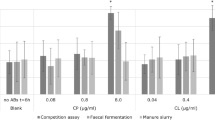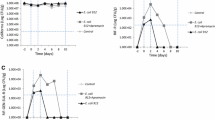Abstract
Escherichia coli strains from swine origin, either susceptible or resistant to colistin, were grown under planktonic and biofilm cultures. After which, they were treated with antibacterial agents including nisin and enterocin DD14 bacteriocins, colistin and their combinations. Importantly, the combination of colistin, enterocin DD14 and nisin eradicated the planktonic and biofilm cultures of E. coli CIP54127 and the E. coli strains with colistin-resistance phenotype such as E. coli 184 (mcr-1 +) and E. coli 289 (mcr-1 −), suggesting therefore that bacteriocins from lactic acid bacteria could be used as agents with antibiotic augmentation capability.

Similar content being viewed by others
References
Bauer-Garland J, Frye JG, Gray JT, Berrang ME, Harrison MA, Fedorka-Cray PJ (2006) Transmission of Salmonella entrica serotype Typhimurium in Poultry with or without antimicrobial selective pressure. J Appl Microbiol 100:1301–1308
Gosh S, LaPara TM (2007) The effects of subtherapeutic antibiotic use in farm animals on the proliferation and persistence of antibiotic resistance among soil bacteria. ISME J 1:191–203
Gao L, Hu J, Zhang X, Wei L, Li S, Miao Z, Chai T (2015) Application of swine manure on agricultural fields contributes to extended-spectrum β-lactamase-producing Escherichia coli spread in Tai’an, China. Front Microbiol 14:313
Michalopoulos A, Falagas ME (2008) Colistin and polymyxin B in critical care. Crit Care Clin 24:377–391
Fairbrother JM, Nadeau E, Gyles CL (2005) Escherichia coli in postweaning diarrhea in pigs: an update on bacterial types, pathogenesis, and prevention strategies. Anim Health Res Rev Conf Res Work Anim Dis 6:17–39
Kempf I, Fleury MA, Drider D, Bruneau M, Sanders P, Chauvin C, Madec JY, Jouy E (2013) What do we know about resistance to colistin in Enterobacteriaceae in avian and pig production in Europe? Int J Antimicrob Agents 42:379–383
Catry B, Cavaleri M, Baptiste K, Grave K, Grein K, Holm A, Jukes H, Liebana E, Navas AL, Mackay D, Magiorakos AP, Romo MA, Moulin G, Madero CM, Pomba MC, Powell M, Pyörälä S, Rantala M, Ružauskas M, Sanders P, Teale C, Threlfall EJ, Törneke K, van Duijkeren E, Edo JT (2015) Use of colistin-containing products within the European Union and European Economic Area (EU/EEA): development of resistance in animals and possible impact on human and animal health. Int J Antimicrob Agents 46:297–306
Liu YY, Wang Y, Walsh TR, Yi LX, Zhang R, Spencer J, Doi Y, Tian G, Dong B, Huang X, Yu LF, Gu D, Ren H, Chen X, Lv L, He D, Zhou H, Liang Z, Liu JH, Shen J (2015) Emergence of plasmid-mediated colistin resistance mechanism MCR-1 in animals and human beings in China: a microbiological and molecular biological study. Lancet Infect Dis 15:424–427
Changkaew K, Intarapuk A, Utrarachkij F, Nakajima C, Suthienkul O, Suzuki Y (2015) Antimicrobial resistance, extended-spectrum β-lactamase productivity, and class 1 integrons in Escherichia coli from healthy swine. J Food Prot 78:1442–1450
Drider D, Rebuffat S (2011) Prokaryotic antimicrobial peptides: from genes to applications. Springer, New York
Drider D, Bendali F, Naghmouchi K, Chikindas ML (2016) Bacteriocins: not only antibacterial agents. Probiotics Antimicrob Proteins. doi:10.1007/s12602-016-9223-0
Vogel L, van Oorschot E, Maas HME, Minderhoud B, Dijkshoorn L (2000) Epidemiologic typing of Escherichia coli using RAPD analysis, ribotyping and serotyping. Clin Microbiol Infect 6:82–87
Liu W, Hansen N (1990) Some chemical and physical properties of nisin, a small-protein antibiotic produced by Lactococcus lactis. Appl Environ Microbiol 56:2551–2558
Al Atya AK, Drider-Hadiouche K, Ravallec R, Silvain A, Vachée A, Drider D (2015) Probiotic potential of Enterococcus faecalis strains isolated from meconium. Front Microbiol 2:227
Abriouel H, Valdivia E, Martínez-Bueno M, Maqueda M, Gálvez A (2013) A simple method for semi-preparative-scale production and recovery of enterocin AS-48 derived from Enterococcus faecalis subsp. liquefaciens A-48-32. J Microbiol Methods 55:599–605
Naghmouchi K, Drider D, Kheadr E, Lacroix C, Prévost H, Fliss I (2006) Multiple characterizations of Listeria monocytogenes sensitive and insensitive variants to divergicin M35, a new pedioci-like bacteriocin. J Appl Microbiol 100:29–39
CA-SFM (2013) Comité de l’antibiogramme de la société française de microbiologie. http://www.sfm-microbiologie.org/UserFiles/files/casfm/CASFM2013vjuin.pdf
Aarestrup FM, Wegener HC, Collignon P (2008) Resistance in bacteria of the food chain: epidemiology and control strategies. Expert Rev Anti Infect Ther 6:733–750
Suzuki S, Hoa PT (2012) Distribution of quinolones, sulfonamides, tetracyclines in aquatic environment and antibiotic resistance in Indochina. Front Microbiol 3:67
Andremont A, Fiona F (2015) What to do about resistant bacteria in the food-chain? Bull World Health Organ 93:217–218
European Food Safety Authority (2012) Technical specifications on the harmonised monitoring and reporting of antimicrobial resistance in Salmonella, Campylobacter and indicator Escherichia coli and Enterococcus spp. bacteria transmitted through food. EFSA J 10:1–64
Tadesse DA, Zhao S, Tong E, Ayers S, Singh A, Bartholomew MJ, McDermott PF (2012) Antimicrobial drug resistance in Escherichia coli from humans and food animals, United States, 1950–2002. Emerg Infect Dis 18:741–749
Tadesse DA, Zhao S, Tong E, Ayers S, Singh A, Bartholomew MJ, McDermott P (2012) Antimicrobial drug resistance in Escherichia coli from humans and food animals, United States, 1950–2002. Emerg Infect Dis 18:741–749
Dijkmans AC, Wilms EB, Kamerling IM, Birkhoff W, Ortiz-Zacarías NV, van Nieuwkoop C, Verbrugh HA, Touw DJ (2015) Colistin: revival of an old polymyxin antibiotic. Ther Drug Monit 374:419–427
Spapen H, Jacobs R, Van Gorp V, Troubleyn J, Honoré PM (2011) Renal and neurological side effects of colistin in critically ill patients. Ann Intensive Care 1:14
Olaitan AO, Morand S, Rolain JM (2014) Mechanisms of polymyxin resistance: acquired and intrinsic resistance in bacteria. Front Microbiol 5:643
Nordmann P, Jayol A, Poirel L (2016) Rapid detection of polymyxin resistance in Enterobacteriaceae. Emerg Infect Dis 22:1038–1043
Arcilla MS, van Hattem JM, Matamoros S, Melles DC, Penders J, de Jong MD et al (2016) Dissemination of the mcr-1 colistin resistance gene. Lancet Infect Dis 16:147–149
Guenther S, Ewers C, Wieler LH (2011) Extended-spectrum beta-lactamases producing E. coli in wildlife, yet another form of environmental pollution? Front Microbiol 2:246
Breukink E, Wiedemann I, van Kraaij C, Kuipers OP, Sahl HG, de Kruijff B (1999) Use of the cell wall precursor lipid II by a pore-forming peptide antibiotic. Science 286:2361–2364
Wiedemann I, Breukink E, vanKraaij C, Kuipers OP, Bierbaum G, deKruijff B, Sahl HG (2001) Specific binding of nisin to the peptidoglycan precursor lipid II combines pore formation and inhibition of cell wall biosynthesis for potent antibiotic activity. J Biol Chem 276:1772–1779
Nissen-Meyer J, Oppegård C, Rogne P, Haugen HS, Kristiansen PE (2010) Structure and mode-of-action of the two-peptide (class-IIb) bacteriocins. Probiotics Antimicrob Proteins 1:52–60
Naghmouchi N, Baah J, Hober D, Jouy E, Rubrecht C, Sané F, Drider D (2013) Synergistic effect between colistin and bacteriocins in controlling Gram-negative pathogens and their potential to reduce antibiotic toxicity in mammalian epithelial cells. Antimicrob Agents Chemother 57:2719–2725
Naghmouchi N, Drider D, Baah J, Teather R (2010) Nisin A and polymyxin B as synergistic inhibitors of Gram-positive and Gram-negative bacteria. Prob Antimicrob Prot 2:98–103
Naghmouchi N, Belguesmia Y, Baah J, Teather R, Drider D (2011) Antibacterial activity of class I and IIa bacteriocins combined with polymyxin E against resistant variants of Listeria monocytogenes and Escherichia coli. Res Microbiol 162:99–107
Belguesmia Y, Madi A, Sperandio D, Merieau A, Feuilloley M, Prévost H, Drider D, Connil N (2011) Growing insights into the safety of bacteriocins: the case of enterocin S37. Res Microbiol 162:159–163
Allen HK, Trachsel J, Looft T, Casey TA (2014) Finding alternatives to antibiotics. Ann NY Acad Sci 1323:100–191
Cavera VL, Arthur TD, Kashtanov D, Chikindas ML (2015) Bacteriocins and their position in the next wave of conventional antibiotics. Int J Antimicrob Agents 46:494–501
Acknowledgments
Ahmed Khassaf Al Atya received a PhD scholarship from the French and Iraqi governments. The authors are grateful to Campus France for providing funds and Lille 1 University for supporting visiting professorship position for Prof. Hikmate Abriouel. The authors wish to thank the RESAPATH laboratories, Dr. Sophie Granier (Anses) for the mcr-1 positive control and Dr. Benoit Cudennec for statistical analysis.
Author information
Authors and Affiliations
Corresponding author
Ethics declarations
Conflict of interest
Ahmed K. Al Atya, Hikmate Abriouel, Isabelle Kempf, Eric Jouy, Eric Auclair, Anne Vachée and Djamel Drider declare no conflict of interest.
Rights and permissions
About this article
Cite this article
Al Atya, A.K., Abriouel, H., Kempf, I. et al. Effects of Colistin and Bacteriocins Combinations on the In Vitro Growth of Escherichia coli Strains from Swine Origin. Probiotics & Antimicro. Prot. 8, 183–190 (2016). https://doi.org/10.1007/s12602-016-9227-9
Published:
Issue Date:
DOI: https://doi.org/10.1007/s12602-016-9227-9




